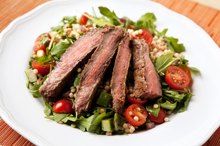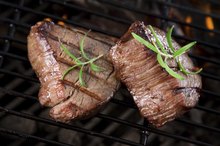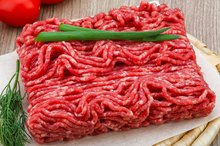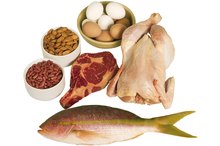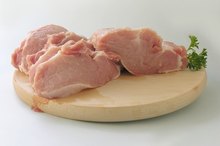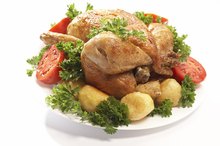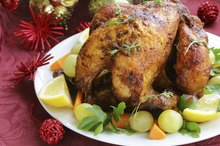What Is the Healthiest Cut of Steak to Eat?
If you are watching your weight or concerned about cholesterol levels, controlling fat intake is a good option. Eating less fat does not mean omitting beef from your diet. In fact, the U.S. Department of Agriculture has implemented a grading system that takes the guesswork out of choosing the healthiest cuts of steak.
Lean and Extra Lean
When it comes to healthy cuts of steak, the leaner the better. Lean cuts contain less fat, which is better for the heart and cholesterol levels. According to Colorado State University Extension, a 3.5-ounce serving of lean steak contains only 10 grams of fat, 4 grams of saturated fat and 95 milligrams of cholesterol. An extra lean cut of steak contains as little as 5 grams of fat, 2 grams of saturated fat and 95 milligrams of cholesterol for every 3.5 ounces.
- When it comes to healthy cuts of steak, the leaner the better.
- An extra lean cut of steak contains as little as 5 grams of fat, 2 grams of saturated fat and 95 milligrams of cholesterol for every 3.5 ounces.
The Top Cut
Serving Size for Tri-Tip Steak
Learn More
The U.S. Department of Agriculture regulates beef standards. Classifications such as lean or extra lean cuts of beef depend on how much fat and cholesterol the cut contains. Approximately 29 types of beef cuts fall into the extra lean category. The top five cuts are steaks: eye round, sirloin-tip side, top round, bottom round and top sirloin. Steaks labeled “round” typically are the leanest of all cuts.
- The U.S. Department of Agriculture regulates beef standards.
- Approximately 29 types of beef cuts fall into the extra lean category.
Check the Label
When choosing the healthiest cut of steak, read the label thoroughly. Some U.S. Department of Agriculture quality beef cuts have “prime” printed on the label. Prime meats tend to have a high fat content. Instead of choosing a prime cut steak, opt for a cut with the label “choice,” “select” or “standard.” According to the Texas AgriLife Extension Service, "choice" steaks contain moderate amounts of fat and "select" cuts contain slight amounts of fat. Standard beef cuts are practically devoid of fat, making them the healthiest.
- When choosing the healthiest cut of steak, read the label thoroughly.
- According to the Texas AgriLife Extension Service, "choice" steaks contain moderate amounts of fat and "select" cuts contain slight amounts of fat.
Trimming the Fat
Can Diabetics Eat Beef?
Learn More
Make a lean cut of steak even healthier by trimming off visible fat before cooking. The University of Illinois’ McKinley Health Center recommends draining the fat from the steak after cooking. Skim the fat from the top of any soups or stews that contain cuts of steak. An easy way to skim the fat is to chill the soup or stew and wait for the fat to harden on top. Simply remove the hardened fat with a small mesh strainer.
- Make a lean cut of steak even healthier by trimming off visible fat before cooking.
- An easy way to skim the fat is to chill the soup or stew and wait for the fat to harden on top.
Related Articles
References
- Beef, loin, tenderloin steak, boneless, separable lean only, trimmed to 0" fat, choice, cooked, grilled. FoodData Central. U.S. Department of Agriculture. Published April 1, 2019.
- Daley CA, Abbott A, Doyle PS, Nader GA, Larson S. A review of fatty acid profiles and antioxidant content in grass-fed and grain-fed beef. Nutr J. 2010;9:10. doi:10.1186/1475-2891-9-10
- Bradlee ML, Mustafa J, Singer MR, Moore LL. High-protein foods and physical activity protect against age-related muscle loss and functional decline. J Gerontol A Biol Sci Med Sci. 2017;73(1):88-94. doi:10.1093/gerona/glx070
- How to keep your immune system healthy. Academy of Nutrition and Dietetics. Updated 2018.
- Avoiding anemia boost your red blood cells. NIH News in Health. Updated 2014.
- Micha R, Michas G, Mozaffarian D. Unprocessed red and processed meats and risk of coronary artery disease and type 2 diabetes--an updated review of the evidence. Curr Atheroscler Rep. 2012;14(6):515-24. doi:10.1007/s11883-012-0282-8
- Pisazka V, Duscher G, Hodžić A, Reider N, Allerberger F. Alpha-gal allergy after a tick bite in Austria. Wien Klin Wochenschr. 2019;131(15-16):385-388. doi:10.1007/s00508-019-1506-5
- Saturated fat. American Heart Association. Updated 2020.
- Meadows L. What's your beef - prime, choice or select?. U.S. Department of Agriculture. Updated 2019.
- Nyquist KM, O'quinn TG, Drey LN, et al. Palatability of beef chuck, loin, and round muscles from three USDA quality grades. J Anim Sci. 2018;96(10):4276-4292. doi:10.1093/jas/sky305
- A fresh look at beef. Berkeley Wellness University of California. Updated 2016.
- Food safety risks for pregnant women. Academy of Nutrition and Dietetics. Updated 2018.
Writer Bio
Jonae Fredericks started writing in 2007. She also has a background as a licensed cosmetologist and certified skin-care specialist. Jonae Fredericks is a certified paraeducator, presently working in the public education system.
